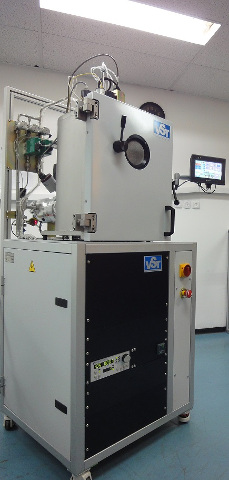Rechercher
Accueil > La Recherche > Axes & Equipes > Physique Appliquée > Chalcogénures : Photovoltaïque et 2D
RF magnetron sputtering
publié le
RF magnetron sputtering is a technique where Argon ions are accelerated by a RF electric field to hit a target made of the material to sputter. The target is sputtered in all directions, in particular, sputtered atoms will reach the substrate placed in front of the target, but outside of the plasma, to prevent etching by the plasma. When a magnetic field is used to fold the ions and electrons trajectories, mean free path is increased and sputtering yield is increased. This technique, named "Magnetron" sputtering greatly increases the growth rate.

We are using a VST technologies equipment, shown below, to deposit both the molybdenum back contact and the undoped/doped ZnO front transparent window.
The equipment is fitted with 3 magnetrons for Mo, ZnO and Al:ZnO. The sample can be heated up to 700°C and the pressure is dynamically regulated in a range from 0.5 to 10 Pa. Argon gas is usually employed, although Oxygen can be used for reactive sputtering.
The molybdenum back contact layer contains very small, acicular grains, which exhibit a given "porosity", allowing sodium from the glass substrate to diffuse into the CIGS layer. This improve the electrical characteristics of the CIGS absorber (reasons mostly unknown ...), but increased porosity is obtained at the expense of contact conductivity.
A good compromise between porosity and conductivity has to be found, and this can be tuned through the deposition pressure. The image below shows the variation of conductivity of the molybdenum layer with deposition pressure (given in Pa in the graph).

The top window is made of a bilayer : undoped ZnO/n+ doped ZnO.
The purpose of the undoped (very thin 50nm) ZnO layer is to "cure" the morphologic defects, like pinholes, which occur in the CdS n type layer below.
Then a thicker well conducting transparent layer, made of Aluminum doped ZnO (AZO) is grown on top to collect the photocreated charges and drive them to the top electrodes.









